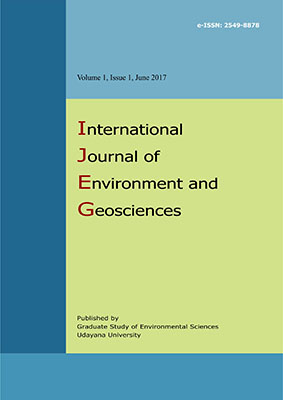Remote Sensing and GIS Approach for Landslide Susceptibility Mapping: A Case Study in Hofu City, Yamaguchi, Japan
Abstract
Landslide is one of the natural hazards that often initiates by the interaction between environmental factors and triggering factor. The identi?cation of areas where landslides are likely to occur is important for the reduction of potential damage. This study utilizes remote sensing data and Geographic Information System (GIS) to identify areas where landslides are likely to occur and generates landslide susceptibility map based on logistic regression model. The study area is located in Hofu city, Yamaguchi prefecture, Japan. The data that were used in this study are satellite imagery from ALOS AVNIR-2, elevation and geology data from GSI, Rainfall data from AMEDAS, and landslide inventory map provided from Ministry of Land, Infrastructure, Transportation and Tourism. The result from this study revealed that elevation from > 50 to < 350 m, slope angle from> 5° to < 50°, slope direction of north and northeast, land cover of agriculture, urban, bare soil, and forest, and lithology of graniodorite, fan deposits, and middle terrace are favorable for landslide occurrence. The landslide susceptiility map showed that 98% of the result calculations of logistic regression are similar to the historical data of landslide event which is among 911 landslide points, 899 points were existed in high and very high susceptibility areas.Downloads
Download data is not yet available.
Published
2017-02-27
How to Cite
NATHANIA, Benita; MUIRA, Fusanori.
Remote Sensing and GIS Approach for Landslide Susceptibility Mapping: A Case Study in Hofu City, Yamaguchi, Japan.
International Journal of Environment and Geosciences, [S.l.], v. 1, n. 1, feb. 2017.
ISSN 2549-8878.
Available at: <https://ojs.unud.ac.id/index.php/ijeg/article/view/28830>. Date accessed: 05 nov. 2025.
doi: https://doi.org/10.24843/ijeg.2017.v01.i01.p04.
Issue
Section
Articles
Keywords
landslide; satellite imagery; geographical information system (GIS); susceptibility mapping
Authors who publish with this journal agree to the following terms:
- All articles published by International Journal of Environment and Geosciences (IJEG) and Graduate Study of Environmental Sciences, Udayana University are made available under an open access license worldwide immediately. This means everyone has free and unlimited access to the full-text of all articles published in International Journal of Environment and Geosciences (IJEG), and everyone is free to re-use the published material given proper accreditation/citation of the original publication. Open access publication is supported by authors' institutes or research funding agency by payment of a comparatively article processing charge for accepted articles (See Author Fees). International Journal of Environment and Geosciences (IJEG) and Graduate Study of Environmental Sciences, Udayana University publish articles under the Creative Commons Attribution License.
- Authors are able to enter into separate, additional contractual arrangements for the non-exclusive distribution of the journal's published version of the work (e.g., post it to an institutional repository or publish it in a book), with an acknowledgement of its initial publication in this journal.
- Authors are permitted and encouraged to post their work online (e.g., in institutional repositories or on their website) prior to and during the submission process, as it can lead to productive exchanges, as well as earlier and greater citation of published work (See The Effect of Open Access).





